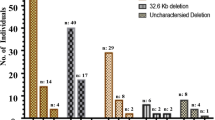Abstract
The HPFH deletion type 2 was first described in a patient from Ghana and is characterized by a large deletion of approximately 105 kb extension. We report here the results obtained in studying a black Brazilian patient who presented an association ofβ -thalassemia and HPFH type 2, using a PCR strategy for detection of the breakpoint region. This procedure allows a rapid molecular identification of this condition and is a reliable procedure for screening patients with a hematological picture of HPFH deletion types.
Similar content being viewed by others
References
Alter BP, Goll SC, Frenov GD, Gravely F, Huisman THJ (1980) Globin chain electrophoresis: a new approach to the determination of theG γ/A γ ratio of globin synthesis. Br J Haematol 44:525–534
Bollenkens JA, Forget BG (1991)δβ-Thalassemia and hereditary persistence of fetal hemoglobin. Hematol Oncol Clin North Am 3:399–422
Bunn HF, Forget BG (1986) Hemoglobin: molecular, genetic and clinical aspects. Saunders, Philadelphia
Craig JE, Barnestson RA, Prior J, Raven JL, Thein SL (1994) Rapid detection of deletions causingδβ-thalassemia and hereditary persistence of fetal hemoglobin by enzymatic amplification. Blood 83:1673
Costa FF, Travello MH, Zago MA (1989) Deletion-typeα-thalassemia among Brazilian patients with sickle cell anemia. Rev Bras Genet 12:605–611
Dacie JV, Lewis SM (1984) Practical hematology. Churchill Livingstone, New York
Henthorn PS, Smithies O, Mager DL (1990) Molecular analysis of deletions in the humanβ-globin clusters. Deletion junctions and locations of breakpoints. Genomics 6:226
Kutlar A, Gardine MB, Headleu MG, Reese AL, Clerk MP, Nagle S, Sukumaron PK, Huisman THJ (1984) Heterogeneity in the molecular basis of three types of HPFH and the relative synthesis of theG γ andA γ types ofγ chain. Biochem Genet 22:21–35
Maniatis T, Fritsch EF, Sambrook J (1989) Molecular cloning: a laboratory manual. Cold Spring Harbor Laboratory, Cold Spring Harbor, NY
Martinez G, Hernandez A, Corral L, Muniz A, Alaez C, Serra A, Alfarano A, Saglio G, Camaschella C (1990) Molecular characterization of HPFH in a patient from Cuba. Blood 76:11262
Morengo-Rowe AJ (1965) Rapid electrophoresis and quantitation of hemoglobin on cellulose acetate. J Clin Pathol 18:790–792
Pembrey MF, MacWade P, Weatherall PJ (1972) Reliable routine estimation of small amounts of fetal haemoglobin by alkali denaturation. J Clin Pathol 25:738–740
Sanger F, Nicklen S, Coulson AR (1977) DNA sequencing with chain termination inhibitors. Proc Natl Acad Sci USA 74:5463–5467
Tuan R, Feingold EA, Newman M, Wlissman SM, Forget BG (1983) Different 3′- end points of deletions causing beta-thalassemia and HPHF: implication for the control ofβ-globin gene expression in man. Proc Natl Acad Sci USA 80:6937
Weatherall DJ, Cligg JB (1981) The thalassemia syndromes. Blackwell Scientific Publications, Oxford
Author information
Authors and Affiliations
Rights and permissions
About this article
Cite this article
Gonçalves, M.S., Fahel, S., Figueiredo, M.S. et al. Molecular identification of hereditary persistence of fetal hemoglobin type 2 (HPFH type 2) in patients from Brazil. Ann Hematol 70, 159–161 (1995). https://doi.org/10.1007/BF01682037
Received:
Accepted:
Issue Date:
DOI: https://doi.org/10.1007/BF01682037




